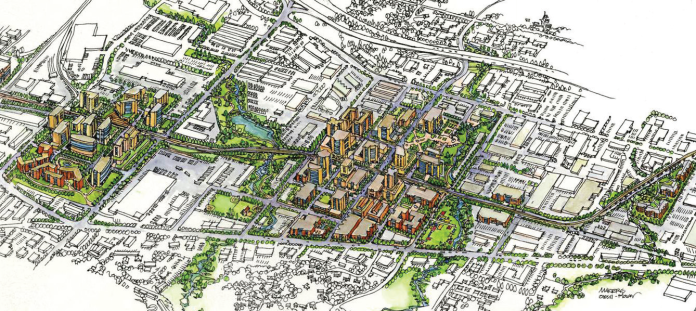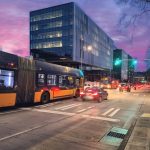Bellevue should plan for high quality public spaces, walkability, and dense transit-oriented development–plus add an in-fill light rail station in Bel-Red.
Walk down Bel-Red Road and you’ll probably find it a bit difficult to tell where exactly you are. Look around and you’ll find few things to guide you; the road seems to listlessly run off towards the horizon (at this point it doesn’t even matter what direction you’re looking) as cars whoosh past just inches away.
What was meant to be a short stroll to the grocery store now seems like it will take an eternity. You can swear that you’ve been walking for half an hour now, but the strip malls and drive-thrus seem to go on forever.
Bellevue is a car city. Traffic lights prioritize them. Roads cater to them. And things are too spread out too far apart as to require them. Taking the bus or biking is possible, yes, but hardly ideal. Driving is ten times faster than walking–and Bellevue’s wide roads are calling.
Over the years there’s been little challenge to the automobile’s supremacy in Bellevue. New roads are still as wide as ever (the roads bounding the transit-oriented Spring District are more than four lanes wide), and bike infrastructure remains lacking.
It’s almost as if Bellevue is a time capsule trapped in 20th-century autopia. It’s still holding on to single-family zoning, increasing housing prices, reducing housing stock growth, and increasing inequality. It’s resilience that’s problematic, an unwillingness to change that’s holding the whole region back. It doesn’t have to be this way–light rail expansion to Bellevue is our chance to rewrite the rules of the city’s urban future.
A Five-Minute City
Imagine that you could leave work on the light rail and read a book while watching the scenery pass by. A lively street lined with small stores greets you as you hop off, and you might even grab some groceries on your way home. The sun shines through the canopy trees onto the path that takes you to your apartment doorstep, where the whole journey from the station to doorstep takes just five minutes. There’s neither sitting in traffic, changing lanes, nor waiting for the light to turn green. That’s what the world of Bel-Red could be.
In its Bel-Red Subarea Plan, the City of Bellevue set about creating a blueprint for Bel-Red and Crossroads neighborhoods once light rail arrives. East Link runs right through the heart of the neighborhoods, making them excellent candidates for transit-oriented development (TOD). Bel-Red is one of the Eastside’s last remaining light industry areas and the Crossroads ranks among Bellevue’s most diverse neighborhoods.
The Subarea Plan itself is built around three key elements: redesigning the street network, restoring nearby creeks and adding green space, and creating dense, mixed-use developments. It’s a bold vision, a top-down approach that’s similar to Bellevue’s plans for Downtown but on a much grander scale. There’re even provisions for inclusionary zoning–a Bellevue first.
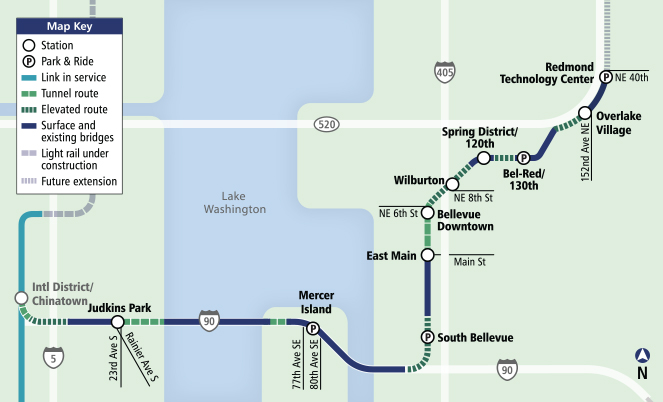
So far though, there hasn’t been much progress. Not much construction has taken place since when the plan was first put forth in 2009, and progress on redesigning the street network seems to have hit a pause. Worse yet, the 130th/Bel-Red Station has morphed into a park-and-ride lot–the pure antithesis of TOD.
But this gives us time to reconsider our next steps. Is the current Bel-Red plan the best we can do? How can we make transit-oriented development in Bel-Red even more vibrant?
Human Scale
Portland is often credited as America’s most walkable city, beckoning with life at every street corner. That’s thanks to its tight street grid where blocks are just 200 feet by 200 feet. Shorter blocks increase storefront space and make for a more conductive environment (you could walk around a shopping mall for hours and not notice!), so they make it easier to get around on foot.
Bel-Red’s current plans call for roughly 300-foot blocks (about the same size as Downtown Seattle’s) from 20th Street down to Bel-Red Road. They would be a fair bit longer than Portland’s–about 50%–which would make it harder to get around on foot (though it wouldn’t be the end of the world). So let’s shorten them to 200 feet. The whole thing might look something like this:
And while we’re on the topic of streets, I’ve often pondered whether some modern streets have car lanes and parallel parking purely to emulate the nostalgic “main street” feel. There doesn’t seem to be much functional purpose for their inclusion of cars: would a car really need to drive down a road that’s only three blocks long? Or how many spaces of parking would really be provided on such a small street, and would those spaces actually be useful?
The better alternative, especially for a TOD project like Bel-Red, is car-free streets. They’ll prioritize foot traffic and tie together the ecodistrict with convenient places where residents can socialize and get a breath of fresh air. Cars drive out all life with their toxic fumes–removing them would create a fountain for life.
In fact, these pedestrian streets or “woonerfs” could be much narrower than regular streets now that the cars are gone. We’ll be building at human scale, not car scale: people will be able to occupy the entire street, not just either side. We’ve been building like this for a millennia already and the result is a homely-feeling space.
Of course, we wouldn’t be able to realistically ban all cars, so we’d only pedestrianize the small streets. Cars can stick to the longer arterials. Parking can also be kept to a minimum since residents won’t need cars to get around (but more on this later).
Spring Boulevard, the street East Link runs in the median of, could even be turned into a shared space–in essence a regular two-lane street but with only transit–that has larger sidewalks and on-street activities. Street users will no longer be breathing in toxic exhaust fumes, and they’ll enjoy much easier access to light rail stations.
Kelsey Creek Station is born
Weirdly, while the City’s redevelopment plan for Bel-Red covers over 900 acres, a lot of it isn’t actually dedicated to mixed-use TOD. If we look closely at the map provided by the city, much of the subarea’s eastern edge remains zoned for lower-density strip malls and housing (shown in coral). It makes some sense–with the light rail station more distant to these areas–but it’s also a missed opportunity. There’s so much land there being wasted by strip malls and parking lots just waiting to be redeveloped into something better. Why not add another light rail station to take advantage of this space?
We can expand our TOD ecodistrict from the Spring District and central Bel-Red to the eastern edge by adding Kelsey Creek Station (named after the nearby creek) on the existing East Link right-of-way about halfway between 20th Street and Spring Boulevard. Like the 130th Station, it would be part of the larger shared space.
Many other cities have built similar shared spaces and they’ve revitalized their downtowns in profound ways–there’s nothing else that can bring people together like transit does.
Parks and Recreation
Despite satellite images displaying Bel-Red as a sea of rather endless concrete, the neighborhood has no less than 3 creeks flowing beneath it (I was quite shocked when I found out too!) Both a testament to the destructive nature of car-oriented planning and a godsend for a sustainable revival, these creeks will certainly become centerpieces of our new Bel-Red community.
The official Subarea Plan already has some great ideas for restoring the creeks so I won’t go too deep here, but here’s the general idea: the three creeks (from west to east: West Tributary of Kelsey Creek, Goff Creek, Kelsey Creek) will be uncovered and widened, and a larger reservoir will be formed on the West Tributary. Trails and public green space line the creeks–private waterfront development is much too unequal. You could kneel down and touch the water as it slowly flows by, or have a picnic on the lawn. It’s not easy to find a place where mother nature will be so accessible.
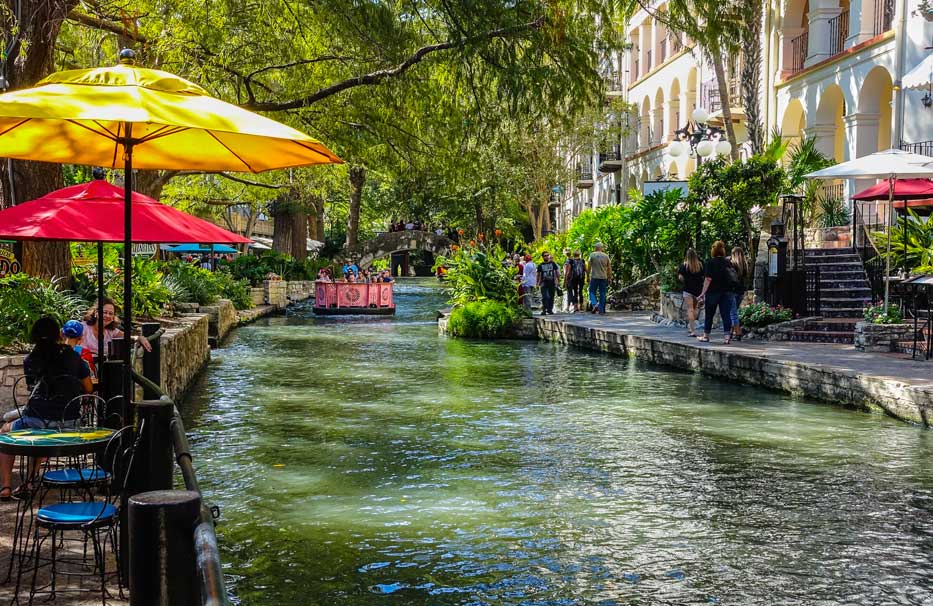
Another route that we could take with the creeks would be to heavily develop a creek along to look something among the lines of the San Antonio Riverwalk. Goff Creek would be the best candidate for this since its central location is the best for setting up shop.
Mimicking the San Antonio Riverwalk would actually be pretty neat; while there would be private stores, the paths and bridges along the river will reinforce its status as a truly unique public space.
Or just opening up a block for park space would do it justice, too. Planting trees, adding greenery, and forging trails would make a world of difference, especially for a neighborhood that currently has little to none.
Opportunities for all
A wide variety of small businesses currently dot Bel-Red’s streets, ranging from car repair shops to tutoring centers, and restaurants that take the taste buds all around the world. There’s Chinese restaurants, ski shops, chess clubs, dance studios, locksmiths, and cultural centers all next to each other. When planning for the next Bel-Red, the sheer diversity it already has must not be lost.
But with Microsoft booming just blocks away and growing employment centers just a light rail ride away, the clock already is ticking for the strip malls dominating the landscape. We’ll need to strike a balance between density and heritage, adding new housing while making sure existing businesses don’t get pushed out (and there’s really nowhere else for them to go).

First off, let’s build housing. High-rise apartments can cluster around the two light rail stations to meet transit demand, and so that the most people possible can have easy access to transit. The buildings will probably look similar to the ones being built downtown, featuring around 200 to 300 homes each and populated by commercial space–grocery stores, salons, restaurants–on their ground levels.
We’ll place an emphasis on small businesses, meaning there won’t be any large indoor shopping malls here. Local small businesses can move into the new mixed-use developments, and, with some rent assistance, should be able to do so without an increase in rent. Some buildings might also have larger ground floors to make room for some workshops or sports studios, or have second floors dedicated to some light industry.
As we move away from the light rail stations, buildings can begin to drop from 30 to about 6 stories, transitioning from high-rises into mid-rises. They’ll be much like their high-rise counterparts, just shorter and cheaper to construct. Many can be designated for affordable housing or Housing First (an initiative to provide unhoused people with permanent supportive housing). Robust inclusionary zoning policies can be applied to developments in the entire subarea to ensure that our region’s economic growth can be shared equitably.
In total, the neighborhood could be home to more than 15,000 people.
Outside connections
Most all TOD in America will inevitably be a walkable island in a sea of car-centrism, Bellevue is very much a suburban city. Those not living in the denser parts of Bellevue still rely on cars as their lifelines, and will continue to do so for years to come.
This means that Bel-Red needs parking. If it doesn’t, it will essentially be cordoned off from the outside world–a disaster for a neighborhood that’s a gathering place for surrounding neighborhoods and the greater region alike. Businesses will suffer from fewer customers, residents might not be able to visit their friends, the list goes on. It’s a sad truth, yes, but one that must be addressed.
We should keep parking to a minimum and spread it out so as to not take up too much space. It’s time to ditch minimum parking requirements—frequently developers supply parking solely to meet regulations, meaning that more spaces are built than are needed, and overconsumption is encouraged. Multi-story garages take up way too much space–and too much parking also costs too much money–at least if our goal is to make a more affordable Bellevue. A single level of structured parking should be sufficient for mid-rise buildings, if off-street parking is provided at all.
And while we’re going to be providing parking, cars won’t be the only users of the streets that lead to them. Outside connections from Bel-Red (and intra-area arterials) need to have good pedestrian and bike infrastructure to best integrate the neighborhood into its surroundings. Converting existing roads like 20th Street and Bel-Red Roads into Complete Streets with wider sidewalks, bike lanes, and fewer car lanes will go a long way here. Both roads have the potential to be modified; they’re plenty wide enough and have inefficient center turn lanes that, if removed, wouldn’t be a loss.
Bellevue is a bubble.
Expensive housing, car-centric planning, and resistance to change in both have made it an enclave that’s largely shielded from the undesirable. Bellevue and Seattle are facing many of the same problems–but the attitude here on the Eastside is significantly more withdrawn. Here, homelessness is frowned upon and too often are problems swept under the rug. For the affordable housing we must build and the equity we must bring, Bellevue is a far cry from progress.
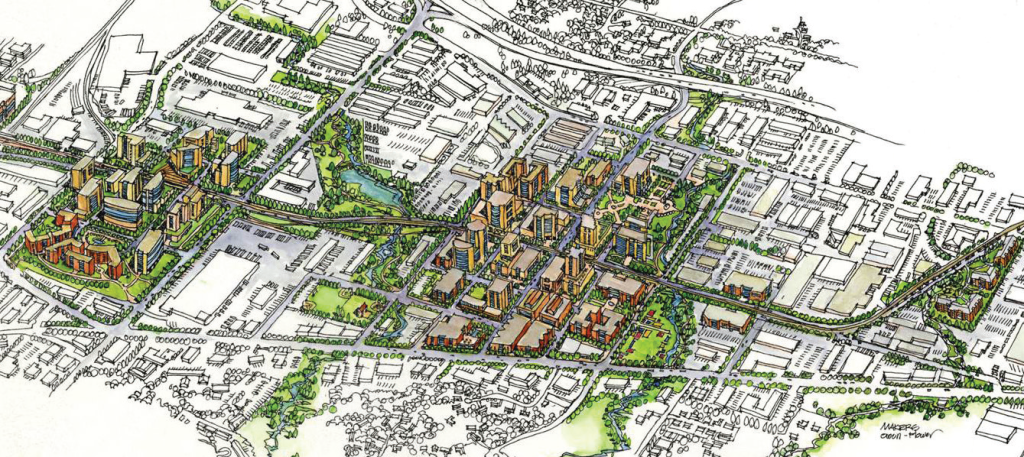
Venture downtown and the streets buzz with life, but the sidewalks don’t. There’s still a divide between pedestrians and cars in Bellevue, one that will remain for the foreseeable future. It’s a strange sight; motorists have to be pedestrians, at least briefly, to park their cars and scamper to their destinations, but we designed Bellevue so that time away from cars is minimal.
The gap between people with metal boxes and those without can’t be bridged without intention, but Bel-Red can do it. It can be a community that’s walkable and transit-rich, diverse and equitable, sustainable and natural. In a desolate sea of sameness, Bel-Red can be the place where we all belong.
Brandon Zuo is a high schooler and enjoys reading about urban planning and transportation. They enjoy exploring the city on the bus and on their bike. They believe that income and racial equality should be at the forefront of urban development. Brandon Zuo formerly wrote under the pseudonym Hyra Zhang.

